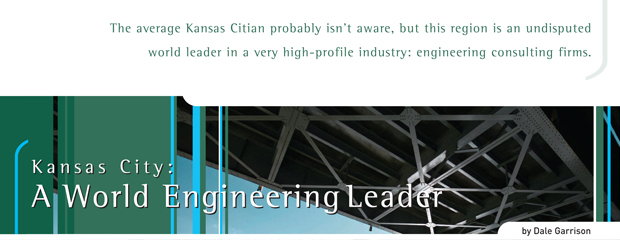Despite economic pressures from the nation’s economy and shortages of material and labor, there’s still a growing demand—and plenty of work for construction companies
“Kansas City doesn’t think of itself
as a place where world-class engineering
is being done,” said the New York-based
Tom Scarangello, chairman of Thornton
Tomasetti. “People don’t understand
the depth of talent that you have there.”
Scarangello said Kansas City taxi drivers
might be the most aware of the city’s
global engineering reach. “They know because
they’re taking us from the airport
to 360 Architects or HOK,” he laughed.Several factors have been involved in
drawing a small army of professionals here. “It’s a critical mass of engineering talent,”
noted Roger Dick of Burns and McDonnell. “There are historic reasons, but all of those
firms have been well managed, with a
national presence. It’s a pretty cool thing
to have right here in Kansas City.”
The “engineering capital of the world”
actually began in the late 1800s and early
1900s when young engineers such as
Clinton Burns, Robert McDonnell, E.B.
Black and Tom Veatch began what
would become Burns and McDonnell,
and Black and Veatch engineering firms.
On a few years removed from the wagon
trains across the Three Trails, their work
was pioneering from the beginning.
“They saw Kansas City as this great
gateway to the West and an emerging
metropolis,” said Greg Graves, president
and CEO of Burns and McDonnell. It was
very attractive to these emerging pioneers.”
These young graduates of Eastern schools
saw here an opportunity to build the
West—a modern West. Bridge projects,
water and waste water systems, and the then-new boom in electrical infrastructure
meant an almost endless demand for
engineering skills.
HNTB Corporation CEO Scott Smith noted that his company’s roots were part of that original wave of engineers with direct ties to the bridge-building firm founded by John Alexander Low Waddell. “Our business building bridges clearly had to do with being on the Missouri river and being on a railroading hub,” Smith explained. “Being close to the Missouri and Mississippi was a big factor in those early days.”
Kansas City’s engineering heyday never waned, and has continued for more than 120 years. After the initial flurry, more firms either flocked to this area or were founded here, including several spin-off companies created by former employees of the initial firms. More growth occurred from developments such as the flood of projects during two world wars.
These weren’t simply local operations.
Even among firms started in the last 20
years, many have grown to become
national in scope, with thousands of
employees and projects that include
some of the most dramatic engineering
efforts in the world.
Staying Power
One of the primary factors in the industry’s
continued strength here is education.
The Big 12 universities, and especially
Missouri and Kansas, have some
of the best engineering programs in the
United States. Not surprisingly, many of those graduates look first to area job
opportunities.
“You have sort of a perfect storm of new engineering and other design graduates who help to staff these companies,” Graves said. “We’re just surrounded by terrific engineering, architectural and environmental programs that graduate great kids.”
There’s also a sort of symbiotic relationship between the schools and engineering firms. “I think we also helped shape the supply of engineers here by providing so much demand for the region’s schools,” Smith added. “Even out to Iowa and Nebraska, those are all strong programs and since we’ve provided a strong demand, it’s just fed that. It’s also a two-way relationship. They listen to the kinds of skills we need and help focus programs in areas we need.”
The sheer size of engineering here is also a factor. After the movement gained momentum, thousands have been employed locally. Satellite and project offices add to that footprint, requiring larger administrative and support staff here even when engineers may be at a distant site.
“We have developed a critical mass
here with the other great firms that have
a high demand of engineering,” Smith
said. “It has created a lot of momentum.”
Dick added, “It’s not widely known
that engineers are only about a third of
our workforce. Architects, technicians
and others play a key role as well.”
Not coincidentally, over the last two
decades, Kansas City has also become the
world capital for sports architecture, and many of the area’s engineering firms
welcome the chance to work with firms
such as Ellerbe Beckett. That further raises
the bar for both talent and capabilities here.
